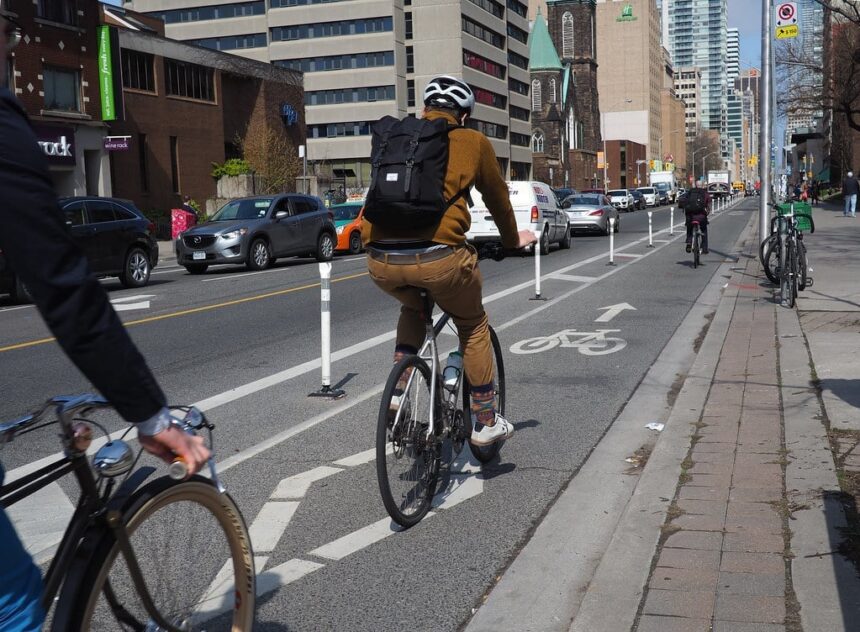In a surprise ruling that sent ripples through both city hall and Queen’s Park, the Ontario Superior Court issued an injunction yesterday halting Premier Doug Ford’s controversial plan to remove several of Toronto’s recently installed bike lanes.
Justice Elena Mikhailov’s 27-page decision temporarily blocks the province from executing what the Premier had called “reclaiming roads for drivers” – a plan that would have seen the removal of 13 kilometers of protected bike infrastructure across downtown Toronto.
“The province has failed to demonstrate how the public interest would be served by removing infrastructure that protects vulnerable road users without conducting proper safety and environmental assessments,” Justice Mikhailov wrote in her decision.
I reviewed the court documents filed by the Cycle Toronto advocacy group and five individual plaintiffs who initiated the legal challenge. Their argument centered on the province’s failure to conduct proper environmental assessments and public consultations before ordering the removal of the bike lanes – infrastructure that was installed following extensive city planning processes.
The ruling comes after months of escalating tension between the provincial government and Toronto’s city council. In April, Premier Ford announced a provincial override of municipal authority through special legislation that would force the removal of bike lanes on University Avenue, Bloor Street, and Danforth Avenue.
“These bike lanes are causing traffic nightmares,” Ford stated at his April press conference. “The war on the car is over.”
David Shellnutt, a lawyer representing the cycling plaintiffs who’s known as “The Biking Lawyer,” told me the court recognized the potential harm of removing safety infrastructure without proper process.
“This ruling affirms that governments can’t simply ignore established environmental assessment procedures,” Shellnutt explained during our phone interview. “The province tried to frame this as merely a transportation efficiency issue, but the court recognized it fundamentally impacts public safety and environmental protection.”
The court cited evidence from Dr. Anne Harris, an epidemiologist at Toronto Metropolitan University, whose research demonstrates that protected bike lanes reduce cyclist injuries by up to 90 percent. The ruling noted that removing this infrastructure without safety alternatives would likely result in increased injuries and possibly fatalities.
Environmental Defence Canada, which filed an amicus brief in the case, provided data showing the bike lanes had reduced carbon emissions in affected corridors by approximately 12% since their installation.
The court found particularly compelling the province’s failure to follow its own Environmental Assessment Act requirements. According to Environmental Defence lawyer Albert Koehl, “The Ford government tried to classify this as maintenance rather than a significant infrastructure change, which would have exempted them from environmental assessments. The court didn’t buy it.”
Court documents reveal that internal ministry emails, obtained through freedom of information requests, showed transportation officials had advised conducting assessments but were overruled by political staff.
City of Toronto data presented to the court showed the bike lanes serve approximately 4,700 cyclists daily. The city’s own traffic studies indicated that while vehicle travel times increased initially after installation, they gradually returned to near-previous levels as traffic patterns adjusted.
For Barbara Gray, Toronto’s General Manager of Transportation Services who testified during proceedings, the ruling validates the city’s evidence-based approach. “We invested significant resources in data collection and community consultation before installing these lanes,” she stated in an affidavit.
The court’s decision doesn’t permanently block the province’s plan but requires proper environmental assessments and meaningful public consultation before any removal can proceed.
Premier Ford expressed disappointment with the ruling but stopped short of confirming whether the province would appeal. “We’re reviewing our options,” Ford told reporters at an unrelated event in Brampton. “But let me be clear – we were elected to solve gridlock problems, and that’s what we’re going to do.”
Toronto Mayor Olivia Chow, who opposed the province’s intervention from the start, called the ruling “a victory for proper process and local democracy.”
“This was never about bikes versus cars,” Chow said during a press conference at city hall. “It’s about following proper planning procedures and respecting the city’s authority to manage its own streets.”
The injunction requires the province to maintain the existing bike lanes until a full hearing can be held, likely in early 2026. The court also ordered the province to pay $75,000 in legal costs to the plaintiffs.
For regular cyclists like plaintiff Maria Hernandez, a dental hygienist who commutes daily along Bloor Street, the ruling brings temporary relief. “These lanes keep me safe every day,” she told me while locking her bike outside the courthouse. “Without them, I honestly don’t know if I would continue cycling to work.”
The case highlights ongoing tensions between provincial authority and municipal governance in Ontario, particularly regarding transportation planning. Under current legislation, the province has ultimate authority over municipalities, but courts have increasingly required governments to follow proper procedures when exercising this power.
According to University of Toronto law professor Alexandra Flynn, who specializes in municipal governance, “This ruling doesn’t challenge the province’s authority to ultimately make these decisions, but it does insist they follow established legal processes around environmental protection and public consultation.”
As both sides prepare for the full hearing, the bike lanes remain in place – with cyclists, drivers, and pedestrians all watching closely to see how this battle over Toronto’s streets will ultimately be resolved.






